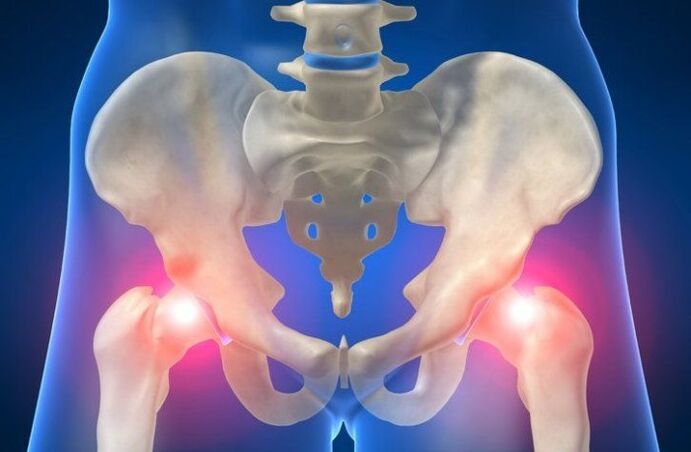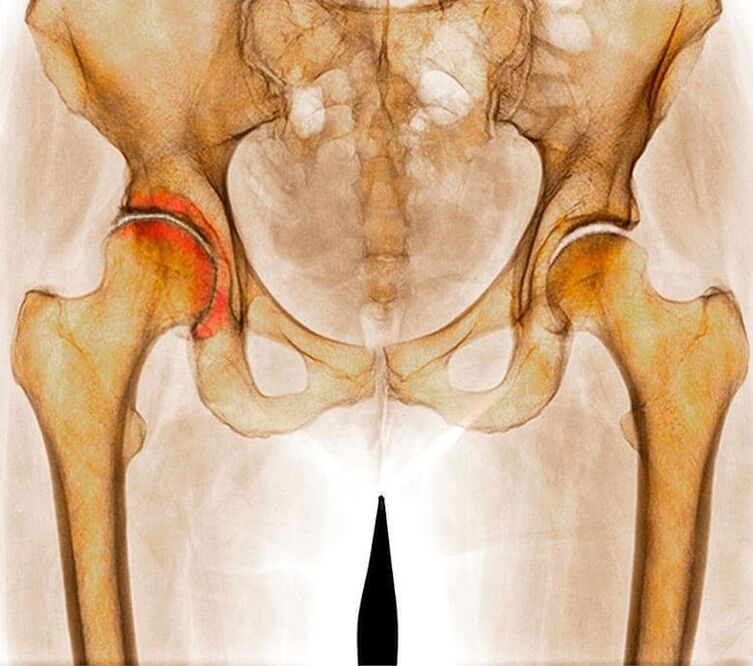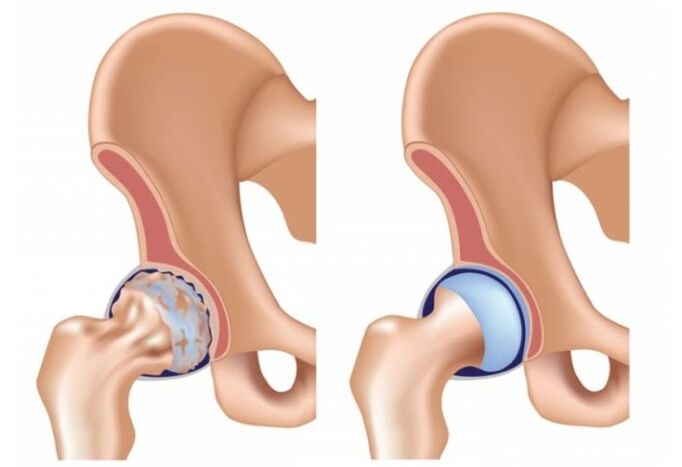The appearance of pain in the hip is a reason for an early visit to the doctor. The sooner the cause of discomfort is determined and treatment is prescribed, the more likely it is that the pain will be completely resolved.
The largest joint in the body is the hip. It represents the biggest and longest daily workload. Its main function is to provide a person with movement and maintain balance. Pain in the hip joint complicates life, brings a lot of discomfort and problems.
In the event of unpleasant symptoms, it is necessary to immediately consult a doctor for help. They can be caused by various diseases. In the first place among the provocateurs of pain are limb injuries.
Less obvious factors that cause pain in the hip joint include the development of pathological processes. The main pathological causes of pain are the presence of:
- arthritis;
- osteoarthritis;
- infectious arthritis;
- inflammatory processes in tendons;
- coxarthrosis and others.

If treatment is not started on time, all these diseases lead to complications, degenerative processes in the joint. These changes mainly include:
- damage to the cartilage surface;
- damage to structures located near the joint;
- decrease in the amount of fluid in the joint.
There are often no obvious causes of hip pain, and the pain does not go away and grows every day. These are signs that an already developed disease is present. To know what disease has developed, you need to see a doctor, but if this is not possible, you can first determine the symptoms and, accordingly, the pathology itself and the methods of solving it.
Wrist injury
The most obvious causes of hip joint pain are injuries. The most common fracture is the neck of the femur. It is the most common because the neck is the thinnest part of the thighs. If the pain is caused by a fracture, then you must be very careful, because this condition is very dangerous. Older people are more likely to get this injury.
Hip pain caused by a fracture should only be treated under medical supervision. In advanced cases, resort to prosthetic or endoprosthetic methods.
Arthritis
This disease mainly affects the elderly. With age, the development of degenerative, dystrophic and inflammatory processes in the joints is often observed. This disease will cause pain in the hip and groin area, pain on the side of the thighs, up to the knee, can occur at night. Leaning on the leg with the painful joint, the patient feels increased pain, and when he gets up from a sitting position, the leg seems to crack.

Pathology is common in people in old age. In this period of life, many people can encounter all degenerative, dystrophic and inflammatory joint processes. One of the first to experience changes is the hip joint.
The main symptoms of arthritis are:
- pain in limbs;
- pain in the inguinal region, spreading to the leg, reaching the knee region;
- increased symptoms when walking;
- shooting when rising from a sitting position.
What to do if the first signs of arthritis appear? In case of severe pain, high temperature, it is necessary to take non-steroidal anti-inflammatory drugs. With their help, you can remove or remove the symptoms of the inflammatory process. Children are prescribed children's forms of medicine.
It is also necessary to rest the painful leg by placing it comfortably. It is strictly forbidden to do any exercises for development. Treatment at the beginning of the disease is conservative. Prosthetic or endoprosthetic surgery is performed in advanced cases.
Coxarthrosis
Coxarthrosis (deforming arthrosis) is a common pathology. The disease occurs mainly in people over 40 years old. In coxarthrosis, the first symptoms can be observed from the beginning of its development. Painful sensations appear in one or both joints, gradually develop. Coxarthrosis is divided into primary (disease of unknown origin) and secondary, the causes and consequences of which are:
- congenital hip dislocations;
- necrosis and tissue destruction of the femoral head;
- improperly formed hip joint;
- Perthes disease;
- injury;
- inflammation.
In primary coxarthrosis, the spine and knee joint can be additionally affected. Changes in the fluid that should lubricate the joint lead to the development of this disease. This causes the surface of the cartilage to dry out, resulting in roughness and cracking. During friction, the cartilage thins, the bones are under great pressure, which causes their deformation in coxarthrosis.

The joint starts to hurt slightly, but with the development of the pathology, the discomfort starts to manifest itself more and more. In the second stage of the disease, severe pain occurs with:
- every time you get up from a sitting position;
- upper body movements;
- the beginning of the walk;
- in walking itself.
The pain spreads to the groin and knee area. There is constant muscle tone in the affected area. This explains the appearance of pain at night.
Over time, blood circulation becomes impaired, which causes the metabolism to slow down. This leads to gradual muscle atrophy. Symptoms of coxarthrosis in stages 2 and 3:
- pain in the hip joint, groin area, knee;
- restricted movements;
- appearance of limping;
- the length of the leg with the affected joint decreases;
- atrophy of the thigh muscles.
In coxarthrosis, pain can occur even at night. Treatment should be prescribed by a doctor after a complete examination. The sooner the patient asks for help, the better and faster the results will be. They also resort to methods of prosthetics and endoprosthetics.
When pain occurs when walking, caused by arthrosis, drug treatment is possible only in the 1st and 2nd stages of development. Stage 3 requires surgery. You should not wait for complete healing (with the exception of arthroplasty). But it is possible to relieve discomfort and pain and stop the development of arthrosis. Medical treatment is carried out:
- pain relievers;
- anti-inflammatory;
- compressions using dimexide;
- physiotherapy.
But this treatment is not enough, complex therapy is needed. Therefore, the doctor can prescribe massage, diet, gymnastics, taking chondroprotectors.
Tendinitis and bursitis of the trochanteric bursa
The trochanteric bursa is located above the prominence of the femur. Inflammation of this part of the musculoskeletal system causes pain in the hip joint and buttocks. If you lie down on the side affected by the sac of fluid, the pain will increase. The inflammatory process can also develop in the iliac crest or ischial pouch, but this happens much less often. The development of the disease can begin after prosthetics and joint arthroplasty.
Tendinitis is an inflammatory process in the tendons. The risk of this pathology is in people who are under constant stress. Basically, this pathology occurs in athletes.
Tendonitis causes pain in the joints during active movements or walking. In a calm state and light loads, there may be no discomfort.
What to do when pain when walking is caused by bursitis or tendonitis should be determined by an orthopedist or traumatologist. In order to save the patient from these pathologies, the specialist prescribes therapy aimed at reducing inflammation. The affected limb must be completely rested. Punctures are prescribed to relieve pain. During the procedure, fluid is pumped out of the bag and antibiotics are injected into it.
In advanced situations, surgical intervention is necessary.
To relieve pain, if chronic pelvic pain syndrome or mild forms of the disease are observed, treatment with alternative methods will help. Keep a few Kalanchoe leaves in the fridge for a day, then squeeze the juice out of them. Make a poultice out of it, which should be changed 6 times during the first days, and then you can put it on only at night.
Chronic pelvic pain syndrome from bursitis is alleviated with compresses made from fresh cabbage or burdock leaves. These sheets must be applied internally to a place previously lubricated with oil or cream. Then it is necessary to wrap the lining with polyethylene, wrap it with a cloth. If such treatment is carried out daily, then the inflammation will subside after 1 to 2 months.
infections
The causative agents of infectious arthritis are influenza viruses, streptococci, staphylococci and other pathogens. If the pain is caused by an infectious disease, the development of other symptoms will not take long. Pain and swelling in the area of the affected joint will not help. A fever may develop, and the pain will torment not only when walking, but also at the slightest movement. Even light touches will bring suffering.
Tuberculous arthritis, which most often affects the hip joint, causes slightly different symptoms:
- The pain first appears during walking. It is not strong, extending to the knee or mid-thigh region.
- After that, hip movements are limited.
- There is swelling in the area of the affected bone.
Heredity
Chronic pelvic pain syndrome is inherited. This is Perthes disease, which is more common in boys but is much more severe in girls. The disease affects one side of the hip joint, sometimes knee pain may occur.
The cause of the disease is myelodysplasia (underdeveloped lumbar spinal cord). Pathology may not bother you all your life. But severe violations cause various orthopedic pathologies. Perthes disease can cause the following causes:
- joint inflammation;
- injury;
- increased stress on the joints.
Symptoms of the disease:
- lameness;
- sharp pain without reason in the knee joint;
- hip joint pain;
- change in gait;
- rise in temperature;
- blood test shows inflammation.
Treatment must be carried out under the supervision of a doctor and according to his recommendations. Patients with Perthes disease are prescribed long-term complex therapy.
Tumors
An articular bone tumor causes pain in the hip joint. Their nature depends on the location and quality of education in the tissues.
The causes of pain in the joint, which extend to the leg, can be the defeat of the joint itself. These include neoplasms in the muscles or bones. The intensity and area of pain are different. This is due to the nature of the tumors (benign or malignant) and their location.
When pain in the joints appears, it is necessary to seek medical help, regardless of the cause that caused this symptom. After all, any joint disease in the initial stage can be cured in a conservative way, without resorting to surgery. But home treatment of the tumor process is unacceptable.



































